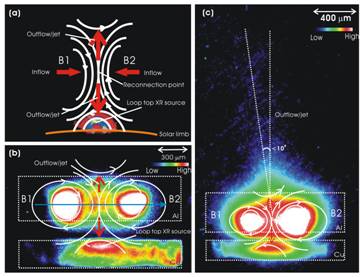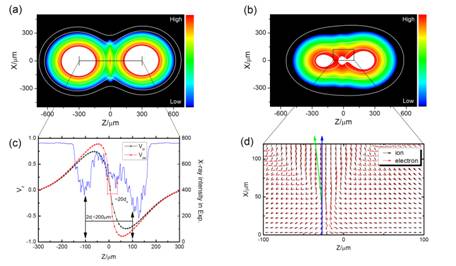Successfully modeling loop-top X-ray source and reconnection outflows in solar flares with intense lasers
Again the research groups on laboratory astrophysics in Chinese Academy of Sciences (CAS) made significant breakthrough this year by continuing the achievements of last year when they simulated the photoionization radiation spectra around the black hole in collaborated with international research groups [Nature Physics 5, 821 (2009)]. This time they successfully modeled the loop-top x-ray source and reconnection outflows in solar flares by using intense lasers. This study was totally based on the domestic research groups and experiment equipments. As early as 2000, Prof. Jie Zhang (Institute of Physics, Chinese Academy of Sciences) and Prof. Gang Zhao (National Astronomical Observatories) jointly proposed to study the astrophysical phenomena in the laboratory, by using high power lasers to produce similar environment to the astrophysical conditions. During the past few years, under the supports of CAS and National Basic Research Program of China (973 Program), the two research groups, together with international collaborators, have been carrying out experiments, theory and numerical simulations on some related topics, and achieved a series of interesting results.
Magnetic reconnection refers to the breaking and reconnecting of oppositely directed magnetic field lines in a plasma. In the process, magnetic field energy is converted to plasma kinetic and thermal energy. It is believed to play an important role in many different plasma phenomena including solar flares, star formation, and other astrophysical events, laser-driven plasma jets, and instabilities in fusion plasmas. The MR process can be constructed by different method in laboratory, such as Z-Pinch and tokamak et al. There are many direct observation evidences for MR model in astrophysical plasmas. The loop-top x-ray source is one of the most famous one in solar flare. In 1994, Masuda et al observed the loop-top X-ray source in solar flares by using the YOHKOH satellite and proposed that two antiparallel magnetic fields were merged above an arcade of closed loops as outflow jets from the reconnection point which collided with high density plasmas on the loop to produce a hot X-ray region. In 2000, Ryutov proposed the scaling law which bridges the different magnetohydrodynamics systems between the astrophysical and laboratory plasmas. In other side, a mega-gauss (MG) magnetic field B could be generated in hot, high-density plasmas by irradiating a solid target with high-power laser beams. During the laser pulse the magnetic field is quasi-steady and approximately “frozen” in the plasma expanding laterally.

Fig.1:(a)The cartoon of loop-top x-ray source in soar flares. (b-c)x-ray images of loop-top x-ray source and reconnection outflows in laboratory. 
Fig.2:X-ray images of MHD simulation (a-b),the scale of ions dissipation region (di) agrees well with experimental result (c), and the asymmetric magnetic field will incline the reconnection outflow(d).The theoretical works are performed with Xiaogang Wang’s group of Peking University.
Based on this quasi-steady state of the magnetic field, the research groups of Professor Jie Zhang (IOP) and Professor Gang Zhao (NAOC) cooperated to reconstruct the topology of magnetic reconnection in laboratory by using Shenguang II laser facilities. They observed the similar results of loop-top x-ray source in solar flares. By applying the scaling law of magnetohydrodynamics they found the physical parameters of both systems are highly similarity. They also found the scale of ions dissipation region agrees well with the theoretical results, while the scale of the electrons dissipation region is larger than the one predicted by theory. The work has been online published on Nature Physics in October 2010.